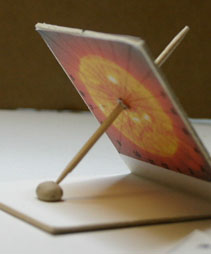A day in the Sun – a brief timelapse video of the garden-size version of the wristdial in action. (See if you can discover what time did the bird land on the dial, casting it’s shadow on the face!) This is the same basic design as the wrist dial, only larger.
Is the wristdial really all those things – inexpensive, simple, one-tooth-pick, global, equatorial, elegant and smaller than an iPod? Yes, and with no moving parts to break. Instead it depends on the motion of the Earth which, ponderous as it is (6.6 sextillion tons) moves like – well, like clockwork!
And simple?
Yep! Here’s an image of the final product in action in the northern hemisphere early on a summer morning. (Oh, it can also find north for you, so it can double as a compass. More on this in the full directions in PDF format 😉
The wristdial travels in a neat, folded package (see inset at upper left). The toothpick is inserted at a right angle to the dial face, and this can be checked with the “setting triangle.” The same triangle is then used to set the dial face so its plane points to the celestial equator. Get those two set correctly, and the dial works anywhere on Earth that the Sun is shining.  The dial has two faces, the one shown in the preceding picture is for use in spring and summer. The other side – shown in the picture at right – is for use in fall and winter. The design can easily be scaled up and faces are included for a larger version, or you can use the instruction included here to design your own.
The dial has two faces, the one shown in the preceding picture is for use in spring and summer. The other side – shown in the picture at right – is for use in fall and winter. The design can easily be scaled up and faces are included for a larger version, or you can use the instruction included here to design your own.
Sundials are simple things that point to profound truths about the motions of Earth and Sun. They’ll teach you about your position on this rapidly spinning sphere and put you in direct touch with some awesome forces of nature. That’s what I love about them. But right now you’re probably more interested in how to make your own wristdial, so let’s do it!
You can download the full directions – with many color photos – from the link below. This is a large Acrobat PDF file, so allow several minutes for it to download. Because of the numerous color image, I suggest you read it on screen – but you’ll want to print either page 4 or page 5, depending on the hemisphere in which you will use the dial.
Download complete directions for wrist dial here: directions_wristdial_f4
You might want to get a jump on things by first finding and jotting down a few useful facts.
Latitude and longitude (http://www.getlatlon.com/) – You don’t have to be super precise. All can be rounded to the nearest degree. For Westport, MA I round my latitude to 42° N, and my longitude to 71° W.
Central meridian (http://www.travel.com.hk/region/timezone.htm) – Time zones are set every 15 degrees of longitude so you’ll see the central meridian for yours at the top of the map on the web page linked above. Westport, MA, is in the Eastern Standard time zone which is centered on 75 degrees longitude.
Compass deviation (http://www.geo-orbit.org/sizepgs/magmapsp.html) – I suggest you find your compass deviation only because I’m assuming you might use a magnetic compass to find north. If you have another way to determine north, you can ignore this. But a magnetic compass is not precise. In the case of Westport, MA the deviation is 16° east, which means that if my magnetic compass says it is pointing north, it is really pointing 16 degrees to the west of north, so to point true north I have to correct by pointing 16 degrees to the east of what it says is north. Of course, I might use a GPS, or call the local airport to learn the compass deviation.
The wristdial has now been tested in the southern hemisphere by my friend Dom in Sydney, Australia. Dom took some photos of his wristdial in action, next to a larger, traditional garden sundial in Centennial Park. You will note three things about these photos. First, the shadow is on the underside of the dial face because when these photos were taken in mid-July it was winter in the southern hemisphere. Second, the time indicated by the dial is almost exactly the same as the time indicated by Dom’s watch. That’s because Sydney is not on daylight savings time in the winter. Also. Sydney’s longitude is just one degree – four minutes – east of the central longitude for its time zone. Because of that the time should be four minutes fast. But, the equation of time for July is six minutes slow. When you apply the equation of time, the four minutes “fast” caused by a difference in longitude is subtracted from the six minutes “slow” of the equation of time and the dials solar time is within about two minutes of standard clock time. (This kind of calculation is described in detail for your location in the directions you can download. )

Southern hemisphere wristdial showing solar time as compared to clock time while sitting on a traditional sundial in a park in Sydney, Australia.
Filed under: 3. Simple astro-projects, 4. Equipment | Tagged: Astronomy, instructions, solar time, sun dial, wristdial |




Leave a comment